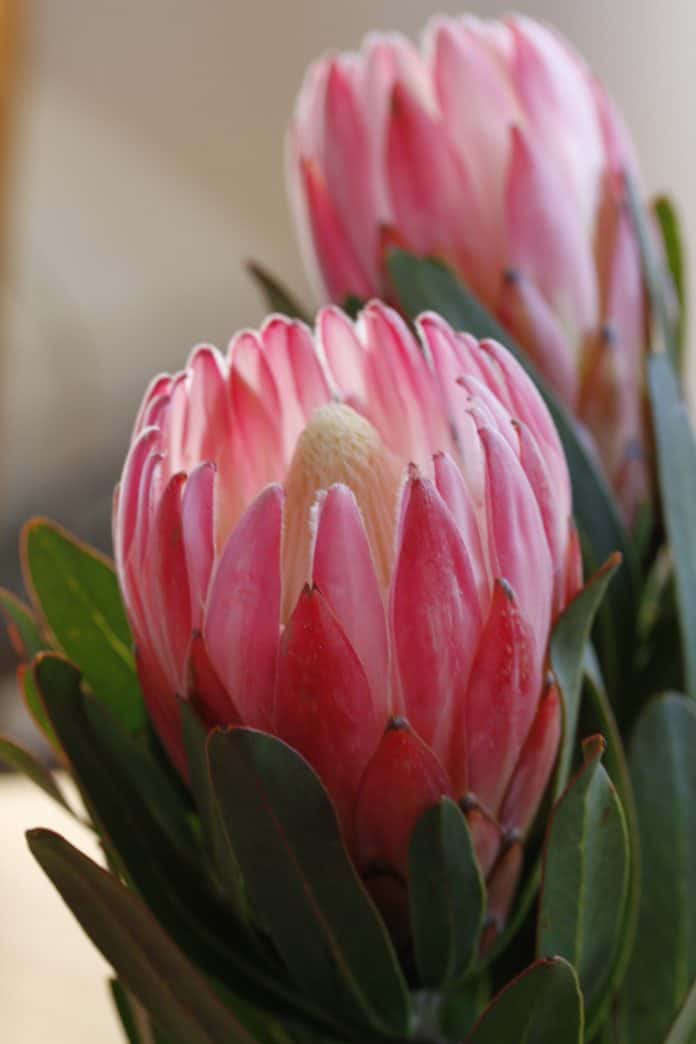A Pink and Creamy Dream: Unraveling the Beauty of the ‘Pink Cream’ Protea
The plant kingdom is full of breathtaking wonders, but few can rival the unique allure of Proteas. These fascinating plants, hailing predominantly from South Africa and Australia, are known for their architectural blooms and hardy nature. Today, we’re diving into the world of one particular cultivar that captivates hearts with its delicate beauty: the ‘Pink Cream’ Protea.
The ‘Pink Cream,’ a hybrid variety of the Protea neriifolia species, is a showstopper in any garden. Its large, cup-shaped flower heads boast a mesmerizing color gradient, transitioning from a soft blush pink at the base to a creamy ivory at the tips. These blooms, often reaching the size of a teacup, are fringed with velvety black hairs, adding a touch of dramatic contrast to their ethereal beauty.
But the allure of the ‘Pink Cream’ goes beyond its captivating appearance. Like other members of the Proteaceae family, this cultivar boasts an intriguing history and remarkable resilience.
A Family Tied to Fire and Ancient Lands:
The Proteaceae family, named after the Greek god Proteus known for his ability to change form, is incredibly diverse. With over 1,600 species ranging from towering trees to ground-hugging shrubs, this family has adapted to thrive in a variety of environments, primarily those with nutrient-poor soils.
One of the most fascinating aspects of Proteas is their relationship with fire. Many species, including the ‘Pink Cream’s’ parent plant Protea neriifolia, are adapted to survive and even thrive after wildfires. Their seeds are often stored in fire-resistant cones, germinating only after the heat of a fire has passed, allowing them to colonize landscapes renewed by fire.
Cultivating Your Own ‘Pink Cream’ Protea:
While native to the Southern Hemisphere, the ‘Pink Cream’ Protea can be successfully grown in other parts of the world with proper care. Here are a few key tips:
- Sun and Soil: Provide your ‘Pink Cream’ with at least six hours of direct sunlight and well-draining soil. They prefer slightly acidic conditions and are sensitive to overwatering.
- Watering: Water deeply but infrequently, allowing the soil to dry out between waterings.
- Fertilizer: Avoid high-phosphorus fertilizers, as they can harm Proteas. Opt for a slow-release, low-phosphorus fertilizer specifically formulated for Proteaceae.
- Pruning: Regular pruning helps maintain a compact shape and encourages bushier growth, leading to more abundant blooms.
More Than Just a Pretty Face:
Beyond their ornamental value, ‘Pink Cream’ Proteas symbolize resilience, transformation, and enduring beauty. Their long vase life makes them popular choices for cut flower arrangements, bringing a touch of exotic elegance to any setting.
Whether you’re a seasoned gardener or just starting to explore the world of plants, the ‘Pink Cream’ Protea is a captivating choice. Its graceful beauty, fascinating history, and relatively easy care requirements make it a truly rewarding addition to any garden or home.



